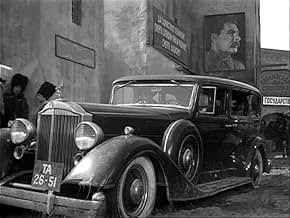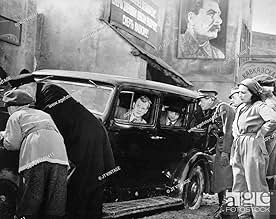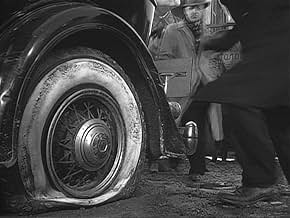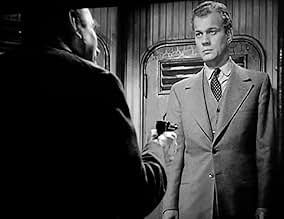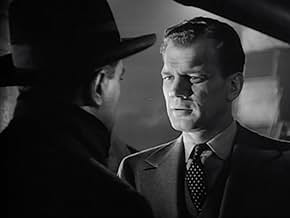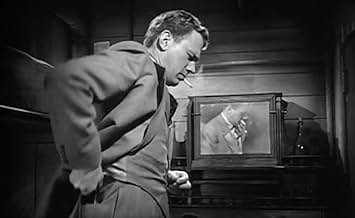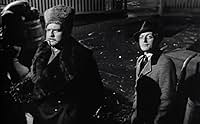VALUTAZIONE IMDb
6,5/10
4995
LA TUA VALUTAZIONE
A Istanbul agenti nazisti assoldano un sicario per eliminare un agente americano che scampa agli agguati grazie alla protezione di un colonnello turco.A Istanbul agenti nazisti assoldano un sicario per eliminare un agente americano che scampa agli agguati grazie alla protezione di un colonnello turco.A Istanbul agenti nazisti assoldano un sicario per eliminare un agente americano che scampa agli agguati grazie alla protezione di un colonnello turco.
- Regia
- Sceneggiatura
- Star
Dolores Del Río
- Josette Martel
- (as Dolores Del Rio)
Anna De Linsky
- Russian Maid at Batumi Hotel
- (non citato nei titoli originali)
Jerome de Nuccio
- Turkish Officer
- (non citato nei titoli originali)
Herbert Drake
- Ship's Steward
- (non citato nei titoli originali)
Recensioni in evidenza
`Journey Into Fear' certainly has an Orson Welles look. Although he received neither directing nor writing credit (credit went to Norman Foster and Joseph Cotten, respectively), I think that most of what is there is his. The problem is that there is not enough there there. The on-board relationships should have been developed more. All of them seem perfunctory.
Combining the shooting by a good marksman who misses his target and stalking him in the nightclub are combined into an altogether more satisfying single event.The escape from the Nazis is more protracted and less violent than in Eric Ambler's book. It is very noirish and photogenic, and the combination of wet chase and the presence of a murky character played by Orson Welles and an all-American one played by Joseph Cotten prefigure `The Third Man.' Joseph Cotten had some of the same American innocence and ready outrage in both films. He's an important munitions engineer here and a hack western writing there. He doesn't get the dark beauty (Alida Valli or Dolores del Rio) in either, though he has and keeps a wife in `Journey.'
The film probably makes sense to those unfamiliar with the book (and such viewers aren't distracted by thinking about what's been changed). It is suspenseful even for someone like me who recently read the book
Combining the shooting by a good marksman who misses his target and stalking him in the nightclub are combined into an altogether more satisfying single event.The escape from the Nazis is more protracted and less violent than in Eric Ambler's book. It is very noirish and photogenic, and the combination of wet chase and the presence of a murky character played by Orson Welles and an all-American one played by Joseph Cotten prefigure `The Third Man.' Joseph Cotten had some of the same American innocence and ready outrage in both films. He's an important munitions engineer here and a hack western writing there. He doesn't get the dark beauty (Alida Valli or Dolores del Rio) in either, though he has and keeps a wife in `Journey.'
The film probably makes sense to those unfamiliar with the book (and such viewers aren't distracted by thinking about what's been changed). It is suspenseful even for someone like me who recently read the book
Somewhere along the way, someone took scissors to this film and left it with plot holes that don't connect. Despite the obvious flaws in continuity and plotting, Eric Ambler's novel has been so changed in transferring it to the screen that he didn't even recognize it as his own story, according to Robert Osborne of TCM.
The marquee value of Joseph Cotten and Orson Welles is likely to lure viewers into thinking they will see another classic along the lines of THE THIRD MAN. Not so. This is a visually interesting espionage yarn, very little of which is coherent and much of which leaves the viewer in as much confusion as Joseph Cotten's character is. Whom should he trust and who is really trying to kill him?
Cotten plays a U.S. Naval engineer aboard a dilapidated freighter who learns that Nazi agents are planning to kill him. The usual Welles Mercury Theater players fill the supporting roles, along with the beautiful Dolores Del Rio. Once the film leaves the claustrophobic freighter and shows Cotten running from his captors, it takes on heightened interest. The scenes in the torrential rain are wonderfully staged and the B&W cinematography gives the illusion of menace in every shadow.
But there is virtually no coherent plot and Welles is completely wasted in a small role that he underplays. While the credits say that Norman Foster directed, it is highly probable that Welles himself directed much of it. Perhaps it all made more sense before the running time was cut down to 71 minutes.
Ruth Warrick has a couple of nice moments as Cotten's patient wife but none of the characters are fleshed out enough to really understand or care about. Cotten gives his usual workmanlike performance but it all ends with a rather abrupt finish, much ado about nothing.
Too many weaknesses to call a classic.
The marquee value of Joseph Cotten and Orson Welles is likely to lure viewers into thinking they will see another classic along the lines of THE THIRD MAN. Not so. This is a visually interesting espionage yarn, very little of which is coherent and much of which leaves the viewer in as much confusion as Joseph Cotten's character is. Whom should he trust and who is really trying to kill him?
Cotten plays a U.S. Naval engineer aboard a dilapidated freighter who learns that Nazi agents are planning to kill him. The usual Welles Mercury Theater players fill the supporting roles, along with the beautiful Dolores Del Rio. Once the film leaves the claustrophobic freighter and shows Cotten running from his captors, it takes on heightened interest. The scenes in the torrential rain are wonderfully staged and the B&W cinematography gives the illusion of menace in every shadow.
But there is virtually no coherent plot and Welles is completely wasted in a small role that he underplays. While the credits say that Norman Foster directed, it is highly probable that Welles himself directed much of it. Perhaps it all made more sense before the running time was cut down to 71 minutes.
Ruth Warrick has a couple of nice moments as Cotten's patient wife but none of the characters are fleshed out enough to really understand or care about. Cotten gives his usual workmanlike performance but it all ends with a rather abrupt finish, much ado about nothing.
Too many weaknesses to call a classic.
Orson Welles graciously denied having any directing role in Norman Foster's 'Journey into Fear (1943),' though his influence appears to be all over it. 'Citizen Kane (1941)' first showcased Welles' fondness for filming people via low and high-angled cameras, a stylistic technique that distorts statures, placing the audience in a position either of power or helplessness. Here, the talented Karl Struss who also worked on such films as 'Sunrise: A Song of Two Humans (1927)' and 'Dr. Jekyll and Mr. Hyde (1931)' employs similar techniques, capturing human faces with a threatening immediacy that distorts their features and suggests imminent danger. You won't, of course, fail to notice that the film's cast also boasts more than a few Welles regulars, mostly members of his Mercury Theatre team Joseph Cotten, Agnes Moorehead, Everett Sloane, Ruth Warrick and Welles himself. The film's screenplay was written by Cotten, his sole attempt at writing {outside some uncredited work on 'The Magnificent Ambersons (1942)'}, a pity since the dialogue is frequently crisp, intelligent and memorable.
'Journey into Fear' is one of those rare WWII-themed films of the early 1940s that you wouldn't automatically class as propaganda. Indeed, the Nazis are only mentioned in passing, and the sinister agents who attempt to assassinate Cotten could just as easily be motivated by reasons other than war. Much of the story takes place on a small passenger ship, on which American engineer Howard Graham (Cotten) seeks refuge from German assassins, who are hell-bent on delaying his return home with important Allied intelligence. Silent enemy Peter Banat (played by Welles' agent, Jack Moss) watches ominously from across the ship's cabin, never saying a word, but suggesting sadistic menace through every dryly-amused smirk. Cotten is strong in the lead role, playing Graham as a frightened and confused amateur, a role reminiscent of Holly Martins from 'The Third Man (1949),' rather than the experienced and resourceful American spy we would otherwise expect in such a film. Welles lends his mighty presence to the role of the Turkish Colonel Haki, though he is noticeably more subdued than usual.
In one final manner, 'Journey into Evil' is very much like an Orson Welles film: it was re-edited at the studio's request. According to some sources, Welles did some of the trimming himself, recutting the final reel and adding Joseph Cotten's rather awkward narration. At just 68 minutes in length, the film certainly feels as though it has been tampered with. The relationship between Graham and Rosette (Dolores del Rio) is brief and poorly explored, and certainly not worthy of the repeated reassurances that the former frequently bestows upon his anxious wife (Ruth Warrick); there's little indication that the their affiliation extended beyond exchanging a few harmless pleasantries. Though the film doesn't exactly feel incomplete as did a noir like Renoir's 'The Woman on the Beach (1947)' the bare-bones narrative gives the sense of a minor and inconsequential work. Even so, 'Journey into Evil' is well worth seeking out for its terrific photography including a superb climax on the slippery ledges of a hotel exterior and the talents of a very talented cast.
'Journey into Fear' is one of those rare WWII-themed films of the early 1940s that you wouldn't automatically class as propaganda. Indeed, the Nazis are only mentioned in passing, and the sinister agents who attempt to assassinate Cotten could just as easily be motivated by reasons other than war. Much of the story takes place on a small passenger ship, on which American engineer Howard Graham (Cotten) seeks refuge from German assassins, who are hell-bent on delaying his return home with important Allied intelligence. Silent enemy Peter Banat (played by Welles' agent, Jack Moss) watches ominously from across the ship's cabin, never saying a word, but suggesting sadistic menace through every dryly-amused smirk. Cotten is strong in the lead role, playing Graham as a frightened and confused amateur, a role reminiscent of Holly Martins from 'The Third Man (1949),' rather than the experienced and resourceful American spy we would otherwise expect in such a film. Welles lends his mighty presence to the role of the Turkish Colonel Haki, though he is noticeably more subdued than usual.
In one final manner, 'Journey into Evil' is very much like an Orson Welles film: it was re-edited at the studio's request. According to some sources, Welles did some of the trimming himself, recutting the final reel and adding Joseph Cotten's rather awkward narration. At just 68 minutes in length, the film certainly feels as though it has been tampered with. The relationship between Graham and Rosette (Dolores del Rio) is brief and poorly explored, and certainly not worthy of the repeated reassurances that the former frequently bestows upon his anxious wife (Ruth Warrick); there's little indication that the their affiliation extended beyond exchanging a few harmless pleasantries. Though the film doesn't exactly feel incomplete as did a noir like Renoir's 'The Woman on the Beach (1947)' the bare-bones narrative gives the sense of a minor and inconsequential work. Even so, 'Journey into Evil' is well worth seeking out for its terrific photography including a superb climax on the slippery ledges of a hotel exterior and the talents of a very talented cast.
The ingredients are there for first-class international intrigue—Welles, Cotten, an Ambler novel, and the terrific RKO team of D' Agostino and Silvera behind so much of the studio's b&w artistry. So why is the end result short of the classic it should be. IMDb lists 3 uncredited writers in addition to the credited Cotten. Maybe that's why the narrative is so choppy as other reviewers point out. Then too, maybe the studio exercised a heavy hand in the editing room as they were known to do. Whatever the reason, the story never really gels into the suspenser it should be, despite the impressive visuals so clearly Wellsian.
Nonetheless, the nightclub scene especially stays with me. Catch the neatly choreographed staging as the characters dart in and out of the foreground reminiscent of the high-kicking dance scene in Citizen Kane. And who else but a magician (Hans Conreid) would trick himself into a casket with such Wellsian flourish. Note too how visually appropriate non- actor Jack Moss is as the "obese gunman". Apparently, he couldn't be entrusted with any lines, but looking like a mutant garden slug he rivets the eye by sinister presence alone. In fact, this may be the kind of film made more enjoyable by turning down the sound and just reveling in the visuals. Yes indeed, the narrative may disappoint, but the very real Wellsian compensations remain.
Nonetheless, the nightclub scene especially stays with me. Catch the neatly choreographed staging as the characters dart in and out of the foreground reminiscent of the high-kicking dance scene in Citizen Kane. And who else but a magician (Hans Conreid) would trick himself into a casket with such Wellsian flourish. Note too how visually appropriate non- actor Jack Moss is as the "obese gunman". Apparently, he couldn't be entrusted with any lines, but looking like a mutant garden slug he rivets the eye by sinister presence alone. In fact, this may be the kind of film made more enjoyable by turning down the sound and just reveling in the visuals. Yes indeed, the narrative may disappoint, but the very real Wellsian compensations remain.
Well it says Journey Into Fear was directed by Norman Foster, but many sources say it was actually Orson Welles who directed it. Possible of course since this Mercury Theatre production was produced, co- written {with co-star Joseph Cotton} and starred big Orson himself. But wait! Welles is on record as saying he did no directing on the film and it was his friend Foster in the chair. Except for Welles' own scenes which were directed by anyone handy since they were rushing because Welles was due in Brazil to film It's All True! There has also been re-cuts by Welles, added scenes and a narration at the beginning and end that has been and gone over the years. It's all appropriate confusing conjecture tho since the film itself has a strange quirkiness nestling within its arresting visuals.
The story is based on Eric Ambler's highly regarded spy thriller, and sees Howard Graham {Joseph Cotton} as an American engineer, who after a conference in Turkey finds that someone is trying to kill him. We are then thrust into a murky world of espionage where everybody, their motives, and their identities are suspect. Graham is the classic innocent man abroad, we the viewers, as well as everyone in the story but Graham, knows more than he does! I bet Hitchcock loved this film for it be right up his alley. The majority of the film takes place aboard a cramped dilapidated liner, this gives off a wonderfully claustrophobic feel to proceedings. The stifling nature further enhanced by the fact that 99% of the film is set at night time, with Karl Struss' photography utilising shadows and exuding an almost bizarre menacing sheen. There's some nice technical Welles trademarks in here, such as crane shots {the opening scene is moodily awesome} and Welles' well publicised love of magic is given a cute nod during one particularly impacting sequence.
Along side Cotton the cast contains solid performers like Dolores del Rio, Everett Sloane, Ruth Warwick and Agnes Moorehead. But it's Cotton who rightly makes the big impact. Understated and quiet, his Howard Graham infuriates with his inability to grasp what is going on, or to act at times when it clearly calls for the swift clank of brain being put into gear. A real smart bit of casting here from Foster, Welles or whoever! Journey Into Fear, for texture and technical composition belongs in the film-noir genre, certainly as far as the early cycle goes. But really it's a film for the general cinema purists, at times brilliant, at others chaotic, it remains engrossing from start to finish. See it if you can. 8/10
The story is based on Eric Ambler's highly regarded spy thriller, and sees Howard Graham {Joseph Cotton} as an American engineer, who after a conference in Turkey finds that someone is trying to kill him. We are then thrust into a murky world of espionage where everybody, their motives, and their identities are suspect. Graham is the classic innocent man abroad, we the viewers, as well as everyone in the story but Graham, knows more than he does! I bet Hitchcock loved this film for it be right up his alley. The majority of the film takes place aboard a cramped dilapidated liner, this gives off a wonderfully claustrophobic feel to proceedings. The stifling nature further enhanced by the fact that 99% of the film is set at night time, with Karl Struss' photography utilising shadows and exuding an almost bizarre menacing sheen. There's some nice technical Welles trademarks in here, such as crane shots {the opening scene is moodily awesome} and Welles' well publicised love of magic is given a cute nod during one particularly impacting sequence.
Along side Cotton the cast contains solid performers like Dolores del Rio, Everett Sloane, Ruth Warwick and Agnes Moorehead. But it's Cotton who rightly makes the big impact. Understated and quiet, his Howard Graham infuriates with his inability to grasp what is going on, or to act at times when it clearly calls for the swift clank of brain being put into gear. A real smart bit of casting here from Foster, Welles or whoever! Journey Into Fear, for texture and technical composition belongs in the film-noir genre, certainly as far as the early cycle goes. But really it's a film for the general cinema purists, at times brilliant, at others chaotic, it remains engrossing from start to finish. See it if you can. 8/10
Lo sapevi?
- QuizThe great stage actor Richard Bennett had been brought back to films by Orson Welles for L'orgoglio degli Amberson (1942). Although his performance as old Major Amberson has become legendary, it was achieved with great difficulty, as Bennett, by then an old man near death, found it hard to remember his lines, and his eyesight was too poor for him to be able to read cue-cards. Welles's patience in dealing with these problems has been widely described. When he cast Bennett as the ship's captain, he overcame the problems simply by giving Bennett no dialogue at all, although the character has several memorable scenes. It was Bennett's final film role.
- BlooperDuring the chase outside the hotel in the rain, Banat's pistol, a P-08 "Luger" runs out of ammunition, but the action closes normally after he fires the last shot. This particular pistol was designed so that the action stays open after the last round is fired, giving a clear indication to the user that the gun is empty.
- Citazioni
Colonel Haki: Ah, you have this advantage over the soldier, Mr. Graham. You can run away without being a coward.
- Versioni alternativeIn 2005 an alternate cut was shown at the Orson Welles film retrospective in Locarno, Switzerland. It was the original European release print, lacking the narration and ending of the US version but including about eight minutes of footage later deleted by RKO, reportedly for political and censorship reasons. This alternate version, assembled by Stefan Droessler of the Münchner Filmmuseum, was shown at the Museum of Modern Art on Saturday, November 21, 2015.
- ConnessioniFeatured in Terminus... the Theater of Science Fiction: Journey into Fear (1970)
- Colonne sonoreC'est mon coeur
(uncredited)
Written by Steven Morgan
I più visti
Accedi per valutare e creare un elenco di titoli salvati per ottenere consigli personalizzati
- How long is Journey Into Fear?Powered by Alexa
Dettagli
- Data di uscita
- Paese di origine
- Lingue
- Celebre anche come
- Jornada de terror
- Luoghi delle riprese
- Aziende produttrici
- Vedi altri crediti dell’azienda su IMDbPro
- Tempo di esecuzione1 ora 8 minuti
- Colore
- Proporzioni
- 1.37 : 1
Contribuisci a questa pagina
Suggerisci una modifica o aggiungi i contenuti mancanti

Divario superiore
By what name was Terrore sul Mar Nero (1943) officially released in India in English?
Rispondi
